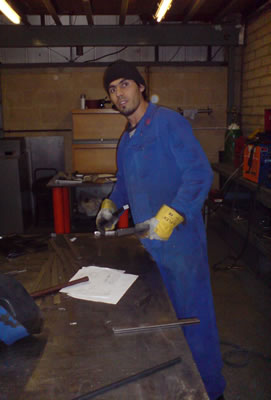Metal fabrication
Metalworking is a trade, art, hobby and industry that relates to metallurgy - a science, jewelery making - an art and craft, as a trade and an industry with ancient roots spanning all cultures and civilisations. Metalworking had its beginnings millennia in the past. Early humans, we speculate, realized different stones had different properties. These were freed metal ores on the earth's surfaces. We can further speculate that some indigenous groups attributed magical and spiritual significance to them. At some imprecise point humankind discovered that these lustrous rocks were meltable, and ductile and able to be formed into various articles for tools, adornment and practical uses. Humans over the millennia learned to work raw metals into objects of art, adornment, trade and practicality.
Through trial and error, and crude harnessing of the malleability of metals, inquisitions as to the sources of these elements probably began. By the historical periods of the Pharohs in Egypt, the Vedic Kings in India, and the Tribes of Israel, and Mayan Civilization in North America among other ancient populations, precious metals began to have value attached to them, and in some cases rules for ownership, distribution, and trade were created, enforced and agreed upon by respective peoples. By the above periods skills at creating objects of adornment, religious artifacts, and trade instruments of precious metals (non-ferrous), as well as implements of inhumanity, and other weaponry usually of ferrous metals and/or alloys were finely honed and flawlessly executed skills and techniques  practised by artisans, blacksmiths, artharva-vedic practicioners, alchemists, and other categories of metalworkers around the globe. For example, the ancient technique of granulation is found spontaneously around the world in numerous ancient cultures before the historic record shows people travelled seas or overland to far regions of the earth to share this process still being used, and attempted by metalsmiths today.
practised by artisans, blacksmiths, artharva-vedic practicioners, alchemists, and other categories of metalworkers around the globe. For example, the ancient technique of granulation is found spontaneously around the world in numerous ancient cultures before the historic record shows people travelled seas or overland to far regions of the earth to share this process still being used, and attempted by metalsmiths today.
As time progressed metal objects became more common, and ever more complex. The need to further acquire and work metals grew in importance. Skills related to extracting metal ores from the earth began to evolve, and metalsmiths became more knowledgable. Metalsmiths became important members of society. Fates and economies of entire civilizations were greatly affected by the availability of metals and metalsmiths. Today modern mining practices are more efficient, and conversely more damaging to the earth, and the workers that are engaged in the industry. Those that finance the operations are driven by profits per ounce of extracted precious metals and today's gold market which as of the date of this editing, are at a 25 year high. The metalworker though depends on the extraction of precious metals to make jewelery, build more efficient electronics, and for industrial and technological applications from construction to shipping containers to rail, and air transport. Without metals, goods and services would cease to move around the globe on the scale we know today. More individuals then ever before are learning metalworking as a creative outlet in the forms of jewelery making, hobby restoration of aircraft and cars,blacksmithing, tinsmithing, tinkering, and in other art and craft pursuits. Trade schools continue to teach welding in all of its forms, and there is a proliferation of schools of Lapidary and Jewelers srts and sciences at this- the beginning of the 21st. Century a.c.e./a.d.
Library content provided by Wikipedia, the free encyclopedia

